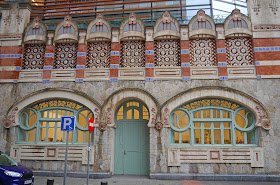From Blackdown Hill towards Pilsdon Pen and Lewesdon Hill
We are nearly at the end of the Dorset section of the Wessex Ridgeway and we've decided on a two-day push to complete it. We pick up the route at Cole's Cross and begin the steady climb up to the top of Blackdown Hill. There is soon a great view back to the southeast of the last two hills we traversed last time: Pilsdon Pen and Lewesdon Hill.
We walk north along the spine of the hill and at the end take a left instead of passing through this inviting gate.
This track descends to join a minor road which leads to the hamlet of Synderford. We take a left and climb up to Yew Tree Farm - we are now heading south, parallel with the ridge of Blackdown Hill. We climb again and follow a field-edge path. Unfortunately, there are extensive electric fences dividing the large field into sections, and none of the gates that farmers usually provide. Eventually we swing right beside a wood. And this large field, a pristine Red Admiral comes and lands right by us to brighten our day.
We cross a road and continue along a track to reach Grighay Farm, rather a handsome building.
Then along farm tracks and across a small field and into a narrow and rather mysterious wood. While we are in the wood it comes on to rain and we emerge into a much more gloomy and damp landscape by Gashay Farm.
We emerge at a road having climbed a large field. There is a pleasant enough view back.
The road soon leads to a complicated junction of small lanes and we follow Hawsmoor Hill, a narrow tarmaced road, to reach Lambert's Castle, a large and rather wonderful iron age hill fort. As we head across it there is a stupendous view to the south and east. It was actually rather hazy and I have used the Haze removal tool in my newly updated version of Photoshop Elements to remove it. The result is a bit too blue, but you can certainly see the horizon more clearly.
The dip in the coastline over to the right is formed by Ridge Cliff on the left and Golden Cap on the right. If you look to the far left, the broad sweep of Chesil Beach is visible, with Portland beyond it.
From the far side of Lambert's Castle we followed a road due south through Coney's Castle and then took a right down towards Wootton Fitzpaine, where we had left the car. The route now went through a massive field of sweetcorn. It was not well marked and we duly lost our way for a while which was a bit frustrating. However, we eventually found our way downhill to the village.
We had parked opposite these fine gates which presumably lead round to the manor house.
Through the gates, just off to the right, is the village church. It is originally 13th century, but has the usual Victorian restorations. Wootton House (I presume) can be seen off to the right - dating from 1765 according to Pevsner, but extended in 1896-7.
Conditions: a lovely sunny day initially, but cloudy and damp later.
Distance: 7.8 miles.
Rating: four stars. Lambert's Castle is arguably one of the most splendid hills in Dorset.


















































